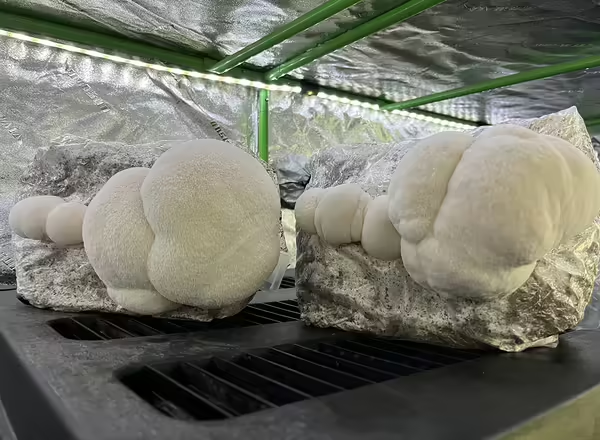
Most of the recent surge in Illinois specialty mushroom production is done with what’s known as bag culture, block culture, bag “tek,” block “tek,” etc.
In block farming, growers create fruiting blocks of mushroom substrate and inoculum to fruit to grow out specialty mushrooms.
Specialty mushroom growers follow several steps to achieve consistent results in creating high-yielding mushroom “fruiting bags” or “fruiting blocks.”
First, substrate material is sourced (typically consisting of either hardwood-based sawdust, straw, or others) and combined/mixed dry with a supplementation material (typically consisting of soybean hull pellets, alfalfa, coffee grounds, or others). The substrate and supplement mix is then transferred to “grow bags.”
Grow bags are typically made of single-use plastic such as polypropylene and include built-in micron filters that allow for oxygen and CO2 exchange between the environment inside the grow bags and the outside without allowing contamination of the mushroom fruiting block substrate
Water is added to the substrate and supplement mix, at which point the grow bags are filled with this mix. Bags are then compressed to expel air, and the bags, with the wetted material inside them, are pasteurized under high temperatures and typically under pressure for several hours using pressure canners, autoclaves, barrel boilers, or other methods, with the objective being to approach near-sterile conditions inside of grow bags
Grow bags, aka grow blocks, are then allowed to cool, transferred to a sterile inoculation room or chamber where specialty mushroom growers trained in amateur mycology are able to inoculate pasteurized bags with mushroom spawn (including sawdust spawn, grain spawn, agar, or other materials).
Grow bags are sealed using an impulse heat sealer and are transferred to a colonization room where they will sit for several days to weeks. During this time, the mushroom spawn that the substrate blocks have been inoculated with will go through the “spawn run” process, colonizing and digesting the pasteurized substrate until the block is ready to expose to mushroom “fruiting” conditions.
At this point, the block is strategically cut in certain locations using a sterile blade, and is then introduced to a “fruiting room” or fruiting chamber, consisting of an environment that is highly controlled to achieve specific levels of temperature, humidity and airflow
The incision that is made in the fruiting block, however small, is typically enough to direct the mycelium inside the mushroom fruiting block to develop a “fruiting body,” aka a mushroom which will eventually protrude from the incisions made in the fruiting block (grow bag).
Once the mushroom grower feels the mushrooms are at the ideal maturity stage, they will be harvested, packaged, and sold.